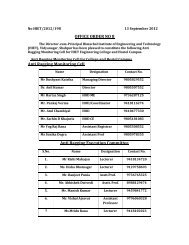Download Syllabus of Mechanical Engineeing. - HIET
Download Syllabus of Mechanical Engineeing. - HIET
Download Syllabus of Mechanical Engineeing. - HIET
You also want an ePaper? Increase the reach of your titles
YUMPU automatically turns print PDFs into web optimized ePapers that Google loves.
Introduction to Computer & Programming in C (CS-1001)<br />
Course Code CS-1001 Credits-4 L-3, T-1, P-0<br />
Name <strong>of</strong> the Course Introduction to Computer & Programming in C<br />
Lectures to be Delivered 52 (1 Hr Each) (L=39, T=13 for each semester)<br />
Semester End Examination Max Marks: 100 Min Pass Marks: 40 Maximum Time: 3 hrs<br />
Continuous Assessment (based on sessional test (2) 50%, Tutorials/Assignments<br />
30%, Quiz/Seminar 10%, Attendance 10%)<br />
Max Marks: 50<br />
Instructions<br />
1. For Paper Setters: The question paper will consist <strong>of</strong> five sections A, B, C, D and E. Section E<br />
will be Compulsory, it will consist <strong>of</strong> a single question with 10-20 subparts <strong>of</strong> short answer type,<br />
which will cover the entire syllabus and will carry 40% <strong>of</strong> the total marks <strong>of</strong> the semester end<br />
examination for the course. Section A, B, C and D will have two questions from the respective<br />
sections <strong>of</strong> the syllabus and each question will carry 15% <strong>of</strong> the total marks <strong>of</strong> the semester end<br />
examination for the course.<br />
2. For Candidates: Candidates are required to attempt five question in all selecting one question<br />
from each <strong>of</strong> the section A, B, C and D <strong>of</strong> the question paper and all the subparts <strong>of</strong> the questions<br />
in section E. Use <strong>of</strong> non-programmable calculators is allowed.<br />
Section A<br />
Fundamental Computer Concept: Operating system fundamentals, disk basics, VDU Basics,<br />
Keyboard basics, introduction to complier, interpreter, assembler, liner and loader and their inter<br />
relationship, Introduction to basics <strong>of</strong> Information Technology.<br />
Section B<br />
Problem solving with Computers: Algorithms, pseudocodes and Flowcharts, Debugging, testing<br />
and documentation, structure-programming concepts, top down and bottom-up design<br />
approaches. Data types, Constants, variables, arithmetic and logical expressions, data inputs and<br />
output, assignments statements, conditional statements.<br />
Section C<br />
Iteration, arrays processing, use-defined data types, functions, recursion, parameter passing by<br />
reference and by value.<br />
Section D<br />
Structure, Multiple structures, Arrays <strong>of</strong> structure, Unions,<br />
Files: reading, writing text and binary files, pointers, character pointers, pointers to arrays, arrays<br />
<strong>of</strong> pointer to structures.<br />
(The programming language C is to be taught along with the course in detail.)<br />
Books:<br />
1. Kanetkar, “Let us C”, BPB Publications<br />
2. Richie and Kerningham, “C Programming”<br />
3. V Rajaraman “Fundamentals <strong>of</strong> computers”<br />
4. D.Dromey, “How to solve it by computers” (Prentics Hall)<br />
5. E. Balaguruswamy, “Programming in C”, Tata McGraw Hill.<br />
10



